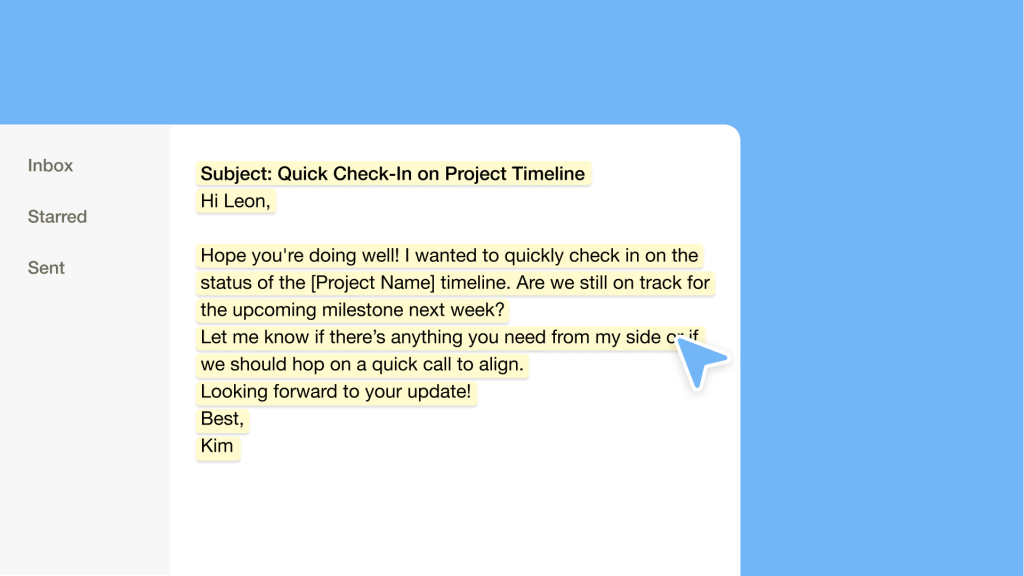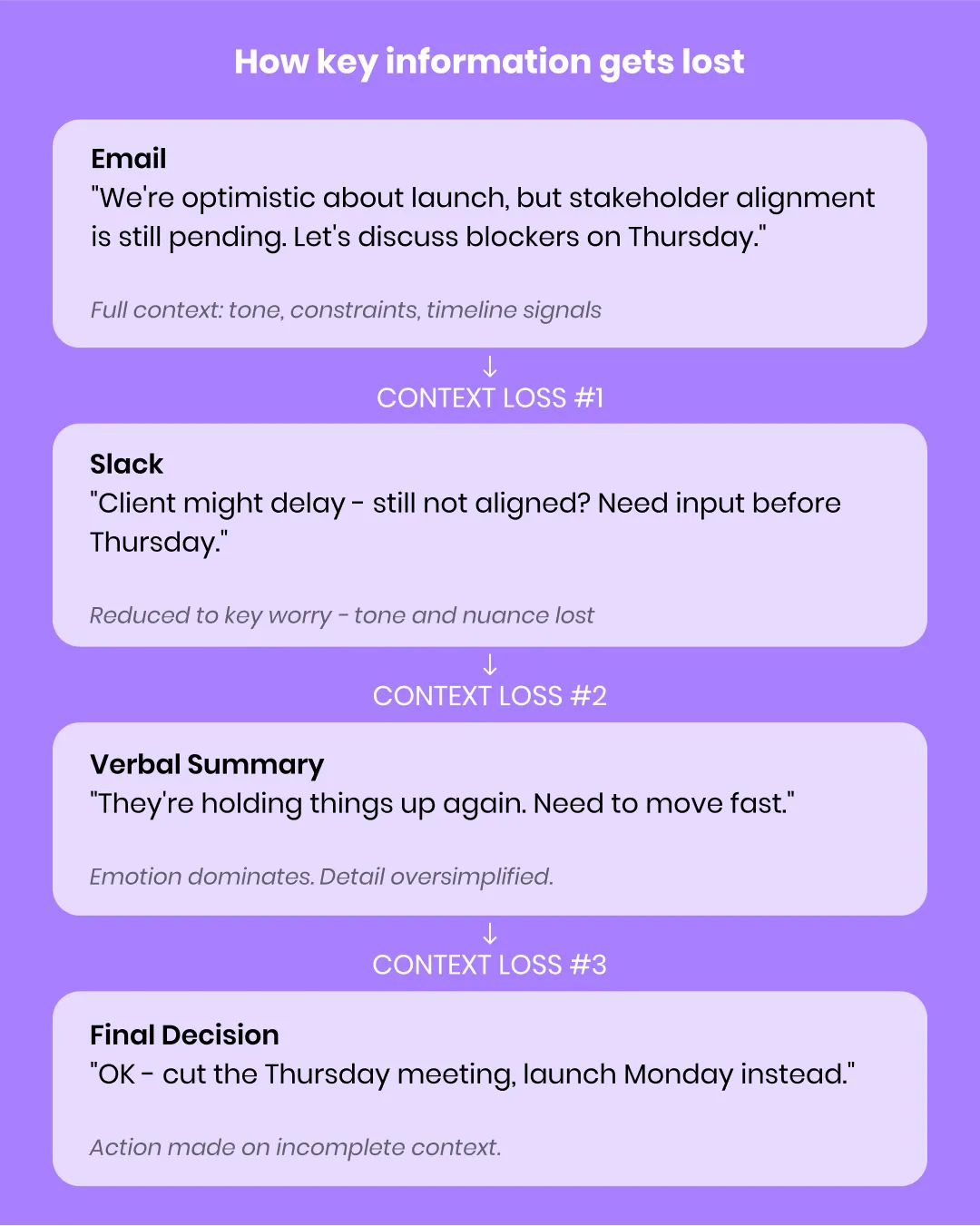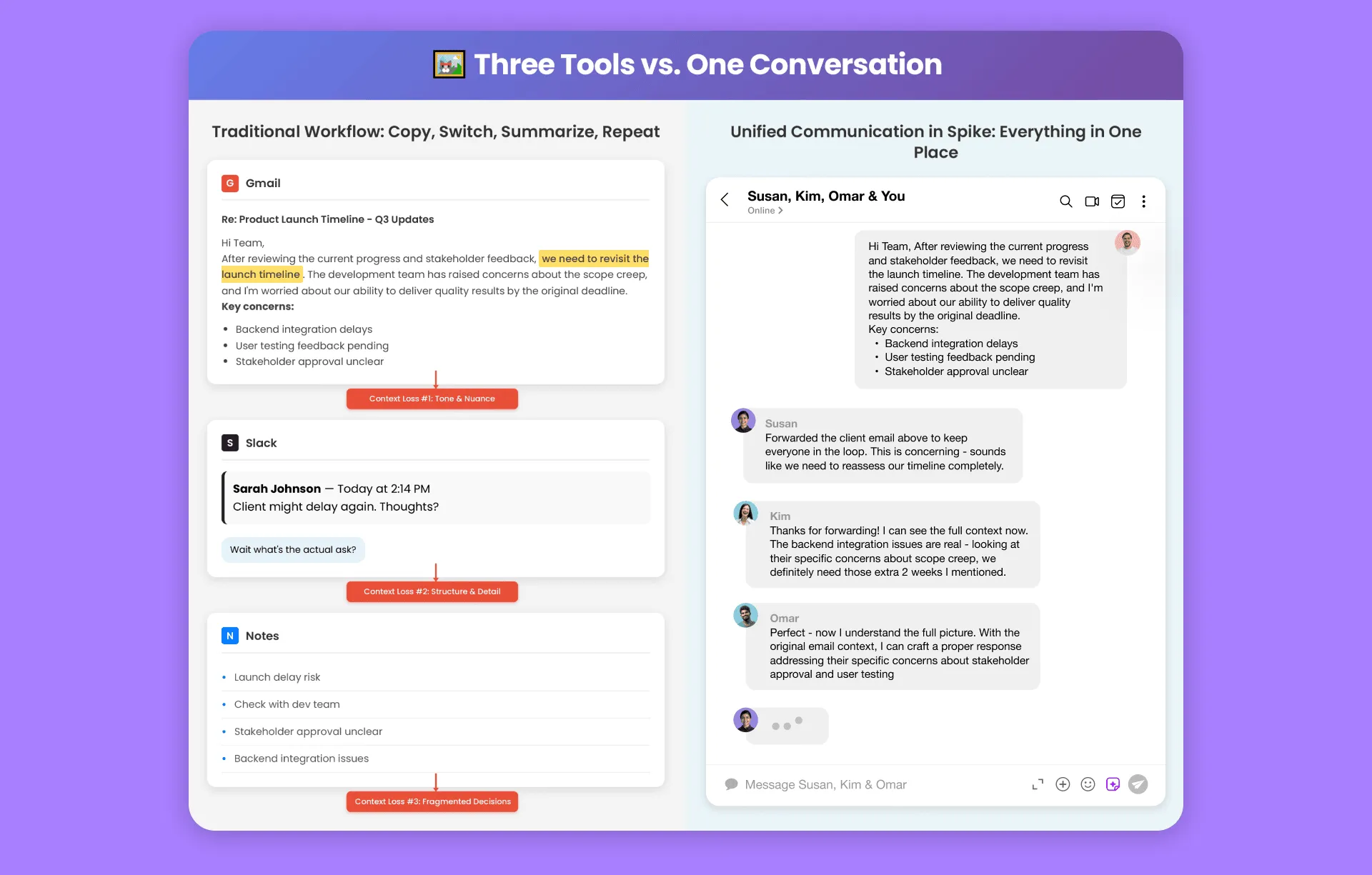The Context Fracture: Why your team can’t afford the gap between email and chat

The client thread has been going for three weeks. Eight people are CC’d, attachments are flying back and forth, and the scope keeps shifting. Your team needs to discuss strategy, but you can’t exactly reply-all with “honestly, I think they’re getting cold feet and we should lower our price.”
So you forward the latest email to Slack. Then someone joins the conversation who missed the forwarded email. Now you have decisions happening in Slack, follow-ups in email, project updates in Notion, and nothing connects back to anything else.
The attachment from last Tuesday gets buried, and when the client mentions “the document Tom shared,” half your team scrambles to figure out what they’re talking about.
Fast forward two weeks. Someone asks “why did we agree to extend the timeline again?” and nobody can trace back through the scattered conversations to remember the logic.
The decision happened somewhere between a forwarded email, a Slack thread, and a hallway conversation, and now it’s just… lost.
This is the context fracture. Not one broken moment, but the slow dissolution of shared understanding across tools that were never meant to work together.
Forwarding helps, but it doesn’t scale

The forwarding helps, but it doesn’t address the underlying issue. When someone from marketing joins the Slack discussion three days later, they don’t scroll back through forwarded emails; they read the summary and jump in.
What looked urgent in the client’s carefully structured email becomes just another message in a stream of notifications. Your team ends up debating strategy based on bits and pieces rather than the full context.
And when the project goes off track weeks later, good luck reconstructing why certain decisions were made. The logic is scattered across forwarded emails that half the team never saw, Slack threads that moved too quickly to follow, and assumptions that were never documented anywhere.
Email and chat weren’t designed to work together
Email works well for what it was built for, i.e., formal communication that needs to be preserved, considered, and referenced later. Chat excels at quick coordination between people who already understand the context. Both tools serve their purpose.
The problem is that most important client work doesn’t fit neatly into either category. You’re trying to manage ongoing relationships that need both careful external communication and rapid internal coordination. The client email thread requires diplomacy and precision, but your team needs to brainstorm solutions quickly and honestly.
And so, you end up living between two systems, manually copying information back and forth. You become a human bridge between incompatible platforms, and every handoff loses something in translation.
What we don’t realize is that we’ve created a system where critical information lives in one person’s head. When you’re the one reading the original client emails, parsing the subtext, and then summarizing for your team, you become the single source of truth for what’s really happening with that client.
This creates all kinds of problems:
- Team members make suggestions based on incomplete information.
- Decisions get made without the full picture.
- When you’re out sick or in back-to-back meetings, the client relationship effectively goes dark because nobody else has the complete context.
The fragmentation isn’t just between tools, it’s between team members. While everyone’s working on the same project, they’re operating from different levels of understanding.
Some people saw the forwarded email, others just caught the Slack summary, and a few only heard about it secondhand. The collective intelligence of your team gets bottlenecked through one person’s interpretation of what the client actually said.
How conversational email resolves the issue

Instead of fighting against how teams actually work, some platforms let client communication and internal discussion happen in the same thread. Spike rebuilt email into a unified environment where external and internal conversations coexist naturally.
When a client email arrives, it shows up with all its original formatting intact. Your team can discuss strategy privately within the same thread – the client can’t see your internal discussion, but it’s visually connected to their message. No copying, pasting, or forwarding required.
Three weeks later when someone new joins the project, they see the whole story in order:
- The original client email with all its context and attachments.
- Your team’s private discussion about how to respond.
- The decisions you made and why you made them.
- Follow-up messages and how the situation developed.
Spike’s AI also provides automatic conversation summaries so new team members can get up to speed instantly without reading through weeks of conversation. When the client references “that document from last Tuesday,” everyone can see exactly what they’re talking about because nothing got lost between tools.
The platform prevents reply-all disasters by design. Your private team discussions exist in a separate visual layer that can never accidentally get sent to the client. But unlike separate Slack channels, the internal conversation stays connected to the original client context that prompted it.
Teams think more clearly when context stays intact
Teams using unified conversation tools report something interesting: projects run more smoothly because they’re not constantly fighting their communication setup.
Decisions improve because everyone is working from the same information. When the whole team can see the client’s original message, including the tone, emphasis, and concerns, they develop a shared understanding instead of operating on one person’s interpretation. Strategy discussions become more nuanced because people can reference the actual client’s words, not someone’s summary of them.
The practical benefits include:
- New team members get up to speed faster because the complete conversation history is in one place.
- Client relationships improve because responses are based on what clients actually said rather than approximations.
- Project timelines become more predictable because less time gets lost to context reconstruction and miscommunication.
When important conversations stay connected to their original context, teams stop operating on assumptions and start working with complete information. The constant anxiety about missing something important disappears because everyone has access to the same full picture.
This problem isn’t permanent. Teams are already using platforms that keep client and internal conversations connected instead of scattered across different tools.
You don’t have to accept that important context will always get lost when you switch between email and chat. You don’t have to keep being the human bridge who manually carries information back and forth. Tools exist that work the way your team actually collaborates on client projects.
The question is whether you want to keep dealing with fragmented conversations or fix the problem.




